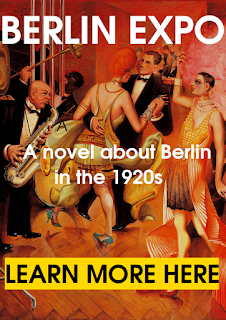Otto Maximilian Umbehr, known as Umbo, was born in Düsseldorf in 1902. He received his first photo apparatus in 1915. From 1921 to 1923 he was
at the Bauhaus in Weimar, where he attended a preparatory class with
Johannes Itten. He became deeply involved in photography in Berlin;
above all portraits, but also experimenting with photogramme and
other techniques and materials.
Umbo had already lived a turbulent life
by the time he was accepted at the Bauhaus : having grown up in poor
circumstances, a school drop-out, a rambler, a coal mine worker, an
artistic potter, the Bauhaus became his field of experimentation for
two years, before he had to leave the school prematurely – it seems
that even there he was seen as ill adjusted. He then spent years
taking a number of different jobs.
 |
| Karstadt store in Berlin-Hermannplatz |
However, the precarious life he had led
took a decisive turn in 1927: through his Bauhaus friend Paul
Citroen, Umbo rediscovered his passion for photography. The first
publications of his work quickly led to fame: his pictures appeared
in numerous magazines, he took part in exhibitions and, as of 1928,
became photo reporter for Dephot, a picture service.
In the twenties, Umbo applied the “New
Photography” imagery to his work, in a manner that was innovative
and surprisingly diverse. His experimental photography was perfectly
suited to the growing media metropolis that was Berlin at the time.
Window display mannequins, strong women, artists, Grock the clown: in
just a few years, he produced a grandiose body of work. In 1928/1929,
"Umbo the Bohemian" was at the peak of his fame, present in
virtually every important avant-garde exhibition and publication.
He pioneered a new aesthetic of
photography and design in inter-war Germany, to little contemporary
success. After dropping out of the Bauhaus school, he retained the
influences and friendships of Johannes Itten and Paul Citroen. While
working as a camera assistant to Walter Ruttmann on his 1927
avant-garde film "Berlin: Die Sinfonie der Großstadt"
(Symphony of a Great City), Umbo created promotional photomontages
for the film, such as the program for its French release. The film's
avant-garde nature, devoid of a structured script or narrative,
married well with the artist's blunt and pointed photographic
presentation, both aiming to present the raw reality of daily life in
Berlin. The photomontages also present sharp political and cultural
commentary through his purposeful collages, such as in The Roving
Reporter (by that surname was the journalist Egon Erwin Kisch known) pictured on the back of this program, which visually conveys
the towering influence of the media and technology over German
society.
 |
| The roving reporter |
 | |
| Symphony of a great city |

 | |
| 1951 |
 |






No comments:
Post a Comment